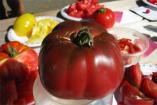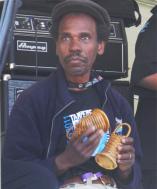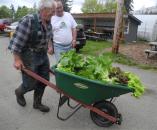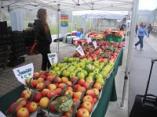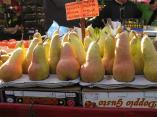Recently I posted a link to Time’s What the World Eats feature (and later found a related article), and have since found an NPR radio feature on the book (Hungry Planet) that these images come from. The NPR page features some interesting background and interviews with the photographers, who enlisted an impressive list of writers to flesh the book out, including Marion Nestle, Alfred W. Crosby, Francine R. Kaufman, Charles C. Mann, Michael Pollan, Carl Safina, and even our upcoming lecturer Corby Kummer.
Last week we had four things to occupy our minds. Still reeling from Serge Latouche‘s lectures, we were offered some therapeutic time in the kitchen with Barny Haughton, as previously reported. Then we had two head-spinning days with Fritjof Capra, a day of gelato, and a concluding meeting with Carole Counihan. I have covered the gelato day separately.
Speaking mainly from his book, The Hidden Connections: A Science for Sustainable Living, Capra explained his theories about food’s systemic role, from the molecular to the environmental level. In brief, he said his view was all about ecosystems; that every living thing – even a cell – is part of a system, and we consider anything in isolation at our peril.
He also expanded on the point that had brought him to Carlo Petrini’s attention: that living things are divided and defined by food. For example, the two categories at the base of the kingdoms, bacteria and protists (single celled nucleated mechanisms), ingest food through semi-permeable cell membranes; the intake of food actually determines the molecular (biological) identity of the cell. Distinctions between the other three kingdoms – fungi, plants and animals (humans) – are also through food. Plants are defined through photosynthesis; fungi send enzymes outside the organism, digest the food outside the organism and then ingest it in digested form. Animals ingest and then digest food. In the human realm: biologically we are animals, but for us food also has its cultural dimension – which we share through communal, social and cultural events. So, he argued, you need to understand cognitive as well as cultural elements to fully understand human relationships with food.
He talked as well about the globalised world: its foundation on the whims of electronic investors, which he described as a global casino. No longer, he said, are companies measured by ‘bricks and mortar’, but by their place in ‘analyst expectations’ – which can change in a moment with immeasurable impact on the lives of the real people who work for those companies, while enriching a global elite. Like us, he had been greatly affected by the film Life Running Out of Control, and its message about our unprecedented destruction of and genetic tampering with existing life forms.
So: to survive on this planet, we must change the rules of the game, he says. The underlying principle that making money is the only company value is outdated and dangerous. Human values are not laws of natures; they can be changed. He urges us to consider a new global civil society, built on networks and an underlying pair of basic values: human dignity – the right to shelter, housing, food, security, free speech, educational and religious freedoms; and ecological sustainability.
Implementing this kind of change includes three areas: addressing the negative impact of globalisation, reshaping governing rules and institutions, through such organisations as the International Forum on Globalisation; agroecology, reshaping food and agriculture, oppositn genetically modified foods and promotion of sustainable agriculture through such organisations as Slow Food; and ecodesign, redesigning technology, buildings and physical structures for sustainability, through such institutions as the Rocky Mountain Institute.
It was a relief to have some tangible resources to explore and find concrete ways to counter the bleak global vision we’d been thinking and talking about. It made me think some more about what and how I think about food; and sustainability and ecosystems have got to have more to do with the total picture.
Barny Haughton had asked if we felt optimistic about the potential for people, companies, countries to change, even in the midst of unassailable evidence of environmental damage. He didn’t get much of an answer, but he himself observed rather bleakly that from his experience he thought people unlikely to change unless forced to do so.
Indeed. We can talk till we are blue in the face about the need for change, but will we give up our cars, our pre-packaged convenience foods, our comfortable heat and cold, our plastics and fossil fuels? Just one more little car ride to the mall when we could have walked. Just one glass bottle we can’t be bothered to wash for the recycling. Just one more package of pre-washed salad with individual portions of inedible dressing, all in full plastic armour. Who else can stop it?
We had concluding food anthropology meetings with Carole Counihan, who shared her research into food cultures in the San Luis Valley of Colorado, and had us share our mini-research (observation studies of local food-related places) with her. Mine was the quirky and I think laudable Progetto Latte, one of several interesting enterprises of the Bertinelli family.

